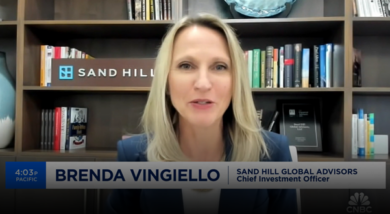“The problem with QE is it works in practice but it doesn’t work in theory.” – Ben Bernanke’s quip in his final public appearance as Chairman of the Federal Reserve
One of the more dangerous phrases used in the investment world is ceteris paribus. All else is seldom equal and the market’s core narrative can shift sharply as conventional wisdom is challenged and overturned. Up until recently, the Federal Reserve’s decision to end its six year bond buying program (known as quantitative easing or ‘QE’ for short) was considered prudent as the economy continued its recovery and the risks created in the aftermath of the 2008 Financial Crisis had dissipated. That narrative is now being challenged.
Following a three year period of unusually low volatility and rising equity markets, market volatility has recently spiked on the back of a wide group of concerns, presently known as the “5 Es” of this market pullback: quantitative easing, European growth, corporate earnings, energy prices, and the growing fear over the Ebola virus. While some of these fears are rational, others appear less so.
In addition, following their recent rise, the markets were arguably elevated moving into this moment, a sixth ‘E’ that typically sets the stage for a normal correction. Indeed, this has been a period of unusually low volatility. Historically, the market tends to experience a 10% pullback on average once per year, and something more significant (greater than a 20% pullback), on average once every three years. Having now gone over three years without a 10% consolidation, we are due. Market consolidations, although painful in the moment, are healthy and tend to reset and rebuild a market’s foundation from which the next leg of a recovery can build moving forward. With that said, let’s explore these prevailing concerns.
The “Great Unwind” of QE is understandably concerning, particularly when the only two meaningful pullbacks over the last six years have coincided with previous attempts to wean the markets from this program. The first attempt, in the spring of 2010, is now primarily associated with the European sovereign debt crisis. The second attempt, in the summer of 2011, occurred as the market wrestled with Standard & Poor’s downgrade of the US Treasury market. In both instances, the market and the economy forced the Fed’s hand to reignite the program, culminating in the electronic creation of more than $3.6 trillion in additional liquidity, or money.
As a result, it is rational to extrapolate from history that a “taper tantrum” would unfold as the Federal Reserve began to take away the market’s long-standing security blanket. However, there have been real quantifiable improvements in the economy over this time; the balance sheets of our large financial institutions have strengthened and market liquidity and functionality has come full circle since 2008. The US job market is the healthiest it’s been since the recovery began, the housing market continues to be robust, corporate earnings are growing, interest rates are highly simulative and inflation pressures are contained. So all else is not equal, given the economy appears to be on solid footing this time around. As a result, in isolation, it is unlikely the removal of QE could produce any lasting impact on the markets. But of course, it never rains, it pours, which brings us to the balance of the 5 Es.
While the market is principally focused on the potential for Europe to slip back into recession, truth be told, over the course of 2014 consensus growth expectations for China, Japan and Europe have all modestly declined, against a more stable US outlook. Further complicating matters, the European Central Bank’s recent actions have proven disappointing relative to their slowing economic backdrop and the once again rising sovereign debt concerns among its troubled periphery. While there has been a loss of economic momentum around the globe, the overall trend remains positive; the US continues to trend at the high-end of our 2-3% growth expectations this year – so it is important to take these headline concerns in stride.
This current global expansion rate, if history is any guide, should be able to produce 6-8% earnings growth for the larger companies in the S&P 500. Slower international growth and a strengthening dollar will certainly become incremental headwinds, but we anticipate the trajectory of earnings to remain positive and supportive to the market over time. Additionally, once these companies report earnings, they can return to their aggressive stock buy-back programs (there is a mandatory 5-week black-out period prior to a corporate earnings release), which has been a supportive factor for the market this cycle particularly. Earnings jitters are a quarterly phenomenon, but we feel confident that the present concerns over corporate earnings will be relegated to history once reporting season comes to a close – at least until next quarter, when of course they will all begin anew.
Meanwhile, falling energy prices, particularly when accompanied by falling stock prices and declining bond yields, have typically been associated with economic ‘growth scares.’ However, this particular sell-off does not appear to be demand related, but rather an issue of excess supply. Due to a variety of geopolitical issues, foreign policy objectives and increased US production capabilities, oil production has ramped significantly. While those conditions are likely to stay in place for some time, we do not believe the swoon in oil prices is a harbinger of an economic slowdown.
Finally, concern over the spread of the Ebola virus has impacted market sentiment. On a humanitarian level it is without a doubt a heart-wrenching story that we hope is contained and controlled quickly. However, from an investment perspective, the economic impact is likely to be relegated to certain geographic as well as specific industries (travel and hospitality). With worldwide mobilization efforts ramping, the likelihood of the virus becoming a sustained developed market issue is very low. As we move past this moment of maximum uncertainty, we believe this fear in the market place will dissipate.
Sand Hill is, by nature, long-term and contrarian. We often tell people we like to “go shopping” when the world goes on sale. Our well-diversified portfolios are deliberately implemented to anticipate volatility along the way as well as deliver solid risk-adjusted total returns over time. One of the reasons we construct portfolios on your behalf in this manner is to protect you from the biggest risk to your financial well-being – scrapping well-laid and disciplined investment plans during difficult times.
Being able to stomach volatility in the market place and take advantage of near-term disruptions in the market for your long-term gain is a hallmark of our process. And that, ceteris paribus, is a great way to take advantage of the differentiated investment opportunities that these transitory moments can create for our clients.
Articles and Commentary
Information provided in written articles are for informational purposes only and should not be considered investment advice. There is a risk of loss from investments in securities, including the risk of loss of principal. The information contained herein reflects Sand Hill Global Advisors' (“SHGA”) views as of the date of publication. Such views are subject to change at any time without notice due to changes in market or economic conditions and may not necessarily come to pass. SHGA does not provide tax or legal advice. To the extent that any material herein concerns tax or legal matters, such information is not intended to be solely relied upon nor used for the purpose of making tax and/or legal decisions without first seeking independent advice from a tax and/or legal professional. SHGA has obtained the information provided herein from various third party sources believed to be reliable but such information is not guaranteed. Certain links in this site connect to other websites maintained by third parties over whom SHGA has no control. SHGA makes no representations as to the accuracy or any other aspect of information contained in other Web Sites. Any forward looking statements or forecasts are based on assumptions and actual results are expected to vary from any such statements or forecasts. No reliance should be placed on any such statements or forecasts when making any investment decision. SHGA is not responsible for the consequences of any decisions or actions taken as a result of information provided in this presentation and does not warrant or guarantee the accuracy or completeness of this information. No part of this material may be (i) copied, photocopied, or duplicated in any form, by any means, or (ii) redistributed without the prior written consent of SHGA.
Video Presentations
All video presentations discuss certain investment products and/or securities and are being provided for informational purposes only, and should not be considered, and is not, investment, financial planning, tax or legal advice; nor is it a recommendation to buy or sell any securities. Investing in securities involves varying degrees of risk, and there can be no assurance that any specific investment will be profitable or suitable for a particular client’s financial situation or risk tolerance. Past performance is not a guarantee of future returns. Individual performance results will vary. The opinions expressed in the video reflect Sand Hill Global Advisor’s (“SHGA”) or Brenda Vingiello’s (as applicable) views as of the date of the video. Such views are subject to change at any point without notice. Any comments, opinions, or recommendations made by any host or other guest not affiliated with SHGA in this video do not necessarily reflect the views of SHGA, and non-SHGA persons appearing in this video do not fall under the supervisory purview of SHGA. You should not treat any opinion expressed by SHGA or Ms. Vingiello as a specific inducement to make a particular investment or follow a particular strategy, but only as an expression of general opinion. Nothing presented herein is or is intended to constitute investment advice, and no investment decision should be made based solely on any information provided on this video. There is a risk of loss from an investment in securities, including the risk of loss of principal. Neither SHGA nor Ms. Vingiello guarantees any specific outcome or profit. Any forward-looking statements or forecasts contained in the video are based on assumptions and actual results may vary from any such statements or forecasts. SHGA or one of its employees may have a position in the securities discussed and may purchase or sell such securities from time to time. Some of the information in this video has been obtained from third party sources. While SHGA believes such third-party information is reliable, SHGA does not guarantee its accuracy, timeliness or completeness. SHGA encourages you to consult with a professional financial advisor prior to making any investment decision.










